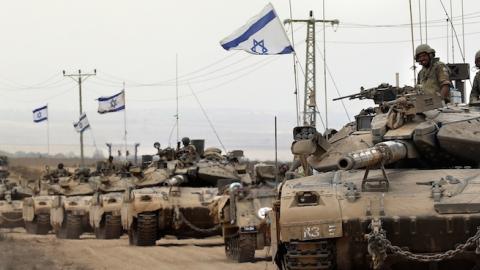**Executive Summary: Many supporters of Israel’s policy in the current Gaza battle argue that the only stronger alternative available for Israel is to reoccupy Gaza – which IDF sources have said might take a year or more of fighting with large numbers of IDF casualties and many Palestinian deaths. Yet, there is a middle way between more of the same and retaking Gaza. The proposed middle way would be an IDF attack which is aimed at finding and killing or capturing as much of the Hamas military leadership as possible, taking and destroying Hamas headquarters and military facilities of all kinds. Instead of avoiding combat with Hamas forces it would seek such combat. The mission of the middle way would not be to destroy Hamas – although it might have that effect. It would have limited, achievable military objectives.**
An attack on the Hamas military leadership and military assets would be a difficult battle, almost certainly causing many Israeli casualties and many Palestinian civilian deaths – mainly because of the Hamas strategy of hiding behind civilians. The IDF may not have proposed such an attack because it is so obviously unattractive and the IDF in recent years has preferred air attack to ground combat. It may be that such an attack is so unattractive that the IDF has not considered the possibility with sympathetic vigor. But perhaps if creative effort were given to figuring out the best tactics for implementing such an attack a way might be found that is not as costly as seems necessary at first glance. Usually defensive deployments like the Hamas system are very effective against most attacks, but have some weakness that makes them vulnerable to the right kind of attack. Well-planned, strong ground attacks – with good air support – are immensely powerful, often achieving better effects than expected.
Even if such an attack were very costly it might – unfortunately – be the best alternative available to Israel. The lives lost by giving such a blow to Hamas might save more lives by delaying or preventing future attacks. There are times when there is a high cost to defending the country in the best way available.
An IDF ground attack against Hamas military forces and assets, which would probably need to last 4 – 6 weeks, would also have substantial political costs. Israel would have to resist frantic demands to stop its assault by the US, European democracies, and the UN. Even Saudi Arabia and Egypt although privately applauding Israel’s campaign, might be forced by their public opinion to call on Israel to desist. On the other hand if Israel demonstrates that it does not have the will to attack Hamas on the ground (or the ability to put it out of action from the air) it will lose some of its value in the eyes of Hamas’ Arab enemies.
This is probably as favorable a political context as Israel will ever have for a prolonged attack on Hamas. Not only is Hamas almost completely isolated politically, but it has rejected several opportunities to end the current battle. Furthermore Israel is already paying a price for its previous attacks on Hamas; it is not clear how much higher the political cost would be if Israel responded to Hamas restarting the battle by an additional six week attack on the Hamas military.
Such a strong attack on Hamas – and on the Palestinian Islamic Jihad (PIJ) –would not be an attempt to end the conflict with Hamas or Gaza. That is an impossible goal. Even if the current Hamas organization were destroyed we have to expect that it will be replaced by a new Hamas or by another Palestinian organization determined to destroy Israel. The attack would be part of a long-term conflict management strategy which includes the principle that the way to limit violence is to make sure that each significant violent initiative by the other side is made into a loss for them (by their calculus).
The goal of the attack would be to capture or kill as much of the Hamas military leadership as possible and to capture or destroy a major share of Hamas headquarters and military facilities. It would also aim to demonstrate to Gazans that Hamas is not ready to stand and fight against the IDF, but when attacked runs and hides like rats. Bringing shame to Hamas would be a heavy blow – producing more deterrence of Hamas and other enemies of Israel than all the damage suffered by the Palestinian population. This does not seem to be an impossible goal for the IDF. It could be achieved even if it is not possible to catch all or almost all of the most valuable 1,000 Hamas military leaders.
If Israel doesn’t make this kind of attack on Hamas and there is a final ceasefire based on Israel accepting any of the Hamas demands and Hamas firing at Israel to the end, some Palestinians and others will see Hamas as gaining a victory, because they attacked Israel and weren’t destroyed.
Deterrence is a main component of Israel’s protection. Not only from Hamas but also from Hezbollah, Syria, and Iran, and from new actors such as the Islamic State (IS) and radical Sunni forces that may control the Syrian side of Israel’s northern border. Israel’s deterrence is much stronger if Israel’s enemies believe that sometimes Israel responds to attacks not just “tit-for-tat,” or by restoring quiet, but by a great blow against its attacker. All of Israel’s enemies are watching what happens in Gaza. Israel will be in more danger if they conclude that the IDF does not have the will, or the political freedom, to use its overwhelming military power.
So far Israel has not hit Hamas hard enough so that it wants a ceasefire. They need to be deterred from starting another gradually increasing drizzle of missile attacks and too afraid to make another major attack as soon as it is able to rebuild its arsenal. If we have to live with Hamas in control of Gaza for some time, we need to hit Hamas at least hard enough so that it cries for a ceasefire to save itself – not to try to impose concessions on Israel. This does not require retaking or reoccupying Gaza; it requires attacking Hamas’ military organization.














